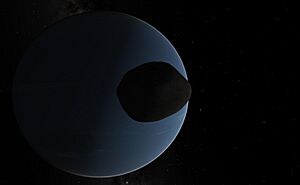Naiad (moon) facts for kids
| Discovered by | Voyager Imaging Team |
|---|---|
| Discovered in | September 1989 |
| Orbital characteristics | |
|
|
|
| Semi-major axis | 48 227 ± 1 km |
| Eccentricity | 0.0004 ± 0.0003 |
| Orbital period | 0.2943958 ± 0.0000002 d |
| Inclination | 4.75 ± 0.03° (to Neptune equator) 4.75° (to local Laplace plane) |
| Is a moon of | Neptune |
| Physical characteristics | |
| Dimensions | 96×60×52 km |
| Mass | ~1.9×1017 kg (based on assumed density) |
| Mean density | ~1.2 g/cm3 (estimate) |
| Rotation period | assumed synchronous |
| Axial tilt | ~zero presumably |
| Albedo (geometric) | 0.07 |
| Surface temp. | ~51 K mean (estimate) |
| Atmosphere | none |
Naiad is the closest moon to the planet Neptune. It is also known as Neptune III. This small moon is named after the Naiads, who were water spirits in Greek legends.
Naiad was discovered in September 1989. It was found in pictures taken by the Voyager 2 space probe. This made it the last moon to be found during the Voyager 2 mission to Neptune. Scientists first called it S/1989 N 6.
Naiad is not shaped like a perfect sphere (a round ball). It is more like an uneven potato. Scientists believe it has not changed much inside since it formed. Naiad orbits very close to Neptune, about 23,500 km above the planet's cloud tops.
Discovering Naiad
Naiad was discovered by the Voyager 2 spacecraft. This probe flew past Neptune in 1989. It took many pictures of the planet and its moons. Naiad was one of the last moons to be identified from these images.
After the Voyager 2 mission, scientists continued to study Neptune. They used powerful telescopes on Earth and the Hubble Space Telescope in space. In 2002-2003, the Keck telescope tried to find Naiad again. It used special technology called adaptive optics. This helped it see clearly through Earth's atmosphere. The Keck telescope easily found the four biggest inner moons of Neptune. It even found Thalassa, another small moon, with some extra work on the images. However, Naiad was too small and faint to be seen again at that time.
Naiad's Orbit
Naiad orbits Neptune very quickly. It completes one trip around the planet in less than one-third of an Earth day. This means it takes about 7 hours and 3 minutes to go around Neptune once.
Naiad's orbit is not perfectly round. It is slightly oval-shaped. It also has a small tilt compared to Neptune's equator. Because it orbits so close to Neptune, Naiad is slowly getting closer to the planet. Eventually, it will either crash into Neptune or break apart into a ring of debris. This process is very slow and will take millions of years.
Physical Features of Naiad
Naiad is a small moon. Its shape is irregular, measuring about 96 kilometers (60 miles) long, 60 kilometers (37 miles) wide, and 52 kilometers (32 miles) thick. It is not massive enough for its own gravity to pull it into a round shape.
Scientists estimate Naiad's mass to be about 1.9 followed by 17 zeros kilograms. This is based on how dense they think it is. Its estimated density is about 1.2 grams per cubic centimeter. This is a bit more than water.
Like many moons that orbit close to their planet, Naiad is likely tidally locked to Neptune. This means that the same side of Naiad always faces Neptune as it orbits. It rotates at the same speed it orbits.
Naiad's surface is very dark. It reflects only about 7% of the sunlight that hits it. This is similar to the color of charcoal. The surface temperature is extremely cold, around -222 degrees Celsius (-368 degrees Fahrenheit). There is no atmosphere on Naiad.
Images for kids
See also
 In Spanish: Náyade (satélite) para niños
In Spanish: Náyade (satélite) para niños



